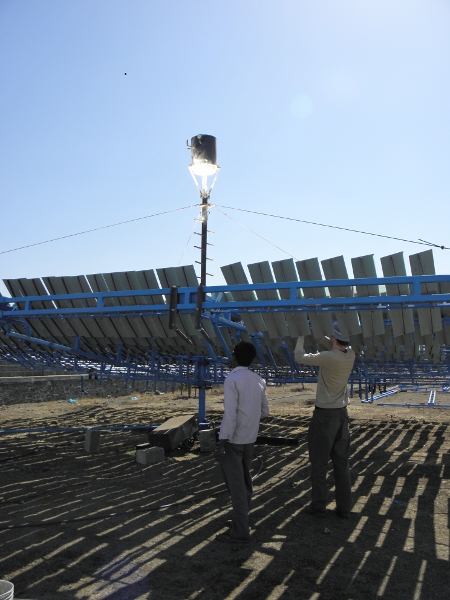The Oil Drum has published its last post. The archive remains accessible.
Open Source Energy Production: The Solar Fire P90
Solar Fire is currently testing a larger version of its low-tech solar concentrator; the Solar Fire P90. Just like its smaller predecessor the Solar Fire P32 (which we covered before), the machine can produce heat, electricity and direct mechanical energy, making it suitable to manufacture almost anything on your roof or in the garden.
The Solar Fire P90 delivers up to 5 kW of electricity and 40 kW of thermal energy, is built using simple, abundant and non-toxic materials, and requires no foundation in the ground. The frame size is 11.5 x 11.5 metres and the machine requires an area of 16 x 16 metres for revolving.
Tracking is done by hand using a simple but ingenious system — one person can operate up to five of these solar concentrators at the same time. The Solar Fire P90 is an open source design, but it can also be bought for about $ 12,000, excluding transport costs.
A video of the tests can be found here. For more information on the workings and applications of these kinds of machines, see the article “The bright future of solar thermal powered factories“.
Picture: Solar Fire.
Energy Cannibalism
Energy cannibalism refers to an effect where rapid growth of an entire energy producing (or conserving) technology industry creates a need for energy that uses (or cannibalizes) the energy of existing power plants or devices. For the deployment of renewable energy and energy efficiency technologies to grow while remaining net greenhouse gas emission mitigators, they must grow at a rate slower than the inverse of their energy payback time.
- “Optimizing greenhouse gas mitigation strategies to suppress energy cannibalism“, J.M. Pearce, 2nd Climate Change Technology Conference, Hamilton, Ontario, Canada, May 12-15, 2009. (PDF).
- “Energy payback for energy systems ensembles during growth“, Timothy Gutowski, International Symposium on Sustainable Systems and Technologies, Washington D.C., May 16-19, 2010. (PDF)
- “Toward real energy economics: energy policy driven by life-cycle carbon emission“, R. Kenny, C. Law, J.M. Pearce, Energy Policy 38, pp. 1969-1978, 2010. (PDF)
- “Thermodynamic limitations to nuclear energy deployment as a greenhouse gas mitigation technology“, Joshua M. Pearce, Int. J. Nuclear Governance, Economy and Ecology, Vol. 2, No. 1., pp.113-130, 2008. (PDF)
Previously: Can renewables power consumer societies? The negative case.
Public versus Private Energy Resources
How To Build Your Own Industrial Civilization
 “The Global Village Construction Set (GVCS) is an open technological platform that allows for the easy fabrication of the 50 different Industrial Machines that it takes to build a small civilization with modern comforts. Key features of the GVCS: Open Source – Low-Cost – Modular – User-Serviceable – DIY – Closed-Loop Manufacturing – High Performance – Heirloom Design – Flexible Fabrication.”
“The Global Village Construction Set (GVCS) is an open technological platform that allows for the easy fabrication of the 50 different Industrial Machines that it takes to build a small civilization with modern comforts. Key features of the GVCS: Open Source – Low-Cost – Modular – User-Serviceable – DIY – Closed-Loop Manufacturing – High Performance – Heirloom Design – Flexible Fabrication.”
“A modern, comfortable lifestyle relies on a variety of efficient Industrial Machines. If you eat bread, you rely on an Agricultural Combine. If you live in a wood house, you rely on a Sawmill. Each of these machines relies on other machines in order for it to exist. If you distill this complex web of interdependent machines into a reproduceable, simple, closed-loop system, you get these 50 machines.”
The GVCS is a work-in-progress. See the wiki, the blog and (the best introduction) the movie.
Related: How to make everything ourselves: open modular hardware.
Can Renewables Power Consumer Societies? The Negative Case
“Virtually all current discussion of climate change and energy problems proceeds on the assumption that technical solutions are possible within basically affluent-consumer societies. There is however a substantial case that this assumption is mistaken. This case derives from a consideration of the scale of the tasks and of the limits of non-carbon energy sources, focusing especially on the need for redundant capacity in winter. The first line of argument is to do with the extremely high capital cost of the supply system that would be required, and the second is to do with the problems set by the intermittency of renewable sources. It is concluded that the general climate change and energy problem cannot be solved without large scale reductions in rates of economic production and consumption, and therefore without transition to fundamentally different social structures and systems.”
Read more: “Can renewables solve the greenhouse problem? The negative case” (pdf), Ted Trainer, Energy Policy, March 2010. Also check out the author’s website, where you can find similar papers, like this one.






